国际经济学作业答案第三章
国际经济学3
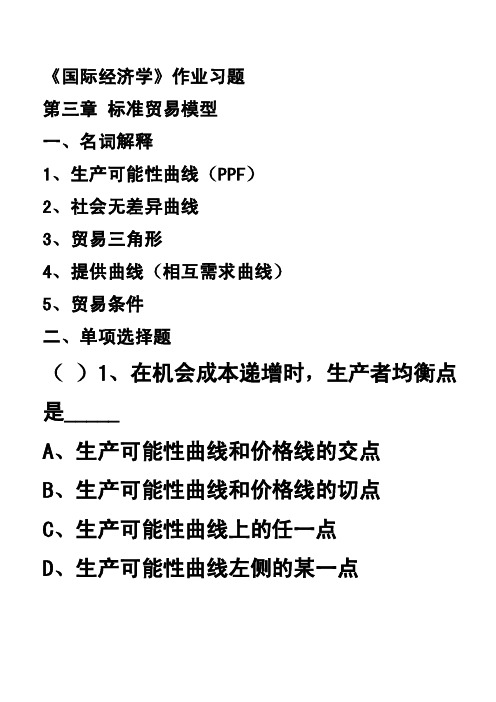
《国际经济学》作业习题第三章标准贸易模型一、名词解释1、生产可能性曲线(PPF)2、社会无差异曲线3、贸易三角形4、提供曲线(相互需求曲线)5、贸易条件二、单项选择题()1、在机会成本递增时,生产者均衡点是_____A、生产可能性曲线和价格线的交点B、生产可能性曲线和价格线的切点C、生产可能性曲线上的任一点D、生产可能性曲线左侧的某一点()2、一国的出口品的价格指数上升,_____A、会导致该国的贸易条件改善B、会导致该国的贸易条件恶化C、不会影响该国的贸易条件D、表明该国出口同样数量的产品,可以换来比过去更少的进口品()3、根据新古典贸易理论,两国可以进行贸易的前提是:_____A、两国的生产可能性曲线形状和位置不同B、两国的社会无差异曲线的形状和位置不同C、两国的资源禀赋不同D、两国封闭经济时的相对商品价格不同三、多项选择题()1、国内封闭经济的均衡点位于_____ A、该国的生产可能性曲线和国内价格线的切点上B、该国的生产可能性曲线和社会无差异曲线的切点上C、该国的社会无差异曲线和国内价格线的切点上D、该国的社会无差异曲线的任一点上E、该国的生产可能性曲线和横轴的交点上()2、当机会成本递增时,生产可能性曲线_____A、是一条向右下方倾斜的直线B、是一条向右下方倾斜并且凹向原点的曲线C、是一条向右下方倾斜并且凸向原点的曲线D、上面各点的斜率是不断变化的E、上面各点的斜率是相同的()3、一国在国际贸易以前和以后的社会无差异曲线不会相交,如果_____A、国际贸易不影响收入分配状况B、国际贸易会影响收入分配状况C、一国居民的偏好改变了D、一国居民的偏好不变()4、两国提供曲线的交点所对应的相对商品价格, _____A、使得一国的出口量等于另一国的进口量B、不能保证一国的出口量等于另一国的进口量C、一定是均衡的相对商品价格D、不一定时均衡的相对商品价格()5、当一种产品的世界市场价格高于一国封闭经济时的均衡价格水平时,_____A、该国可能成为该产品的出口国B、该国可能成为该产品的进口国C、该产品是该国具有比较优势的产品D、该产品是该国具有比较劣势的产品()6、贸易条件恶化是指_____A、出口价格指数不变,进口价格指数上升B、进口价格指数不变,出口价格指数上升C、出口价格指数下降,进口价格指数上升D、进口价格指数下降,出口价格指数上升E、进出口价格指数同时上升四、填空题1、一国的提供曲线凸向该国具有比较____________的商品所在的坐标轴。
国际经济学作业及答案
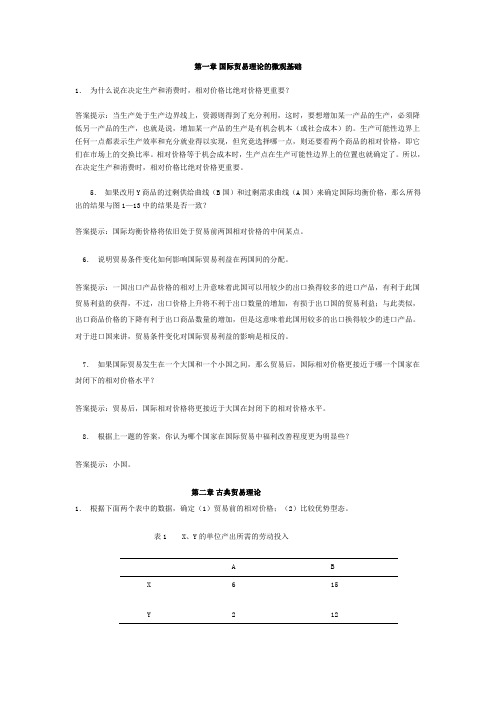
第一章国际贸易理论的微观基础1.为什么说在决定生产和消费时,相对价格比绝对价格更重要?答案提示:当生产处于生产边界线上,资源则得到了充分利用,这时,要想增加某一产品的生产,必须降低另一产品的生产,也就是说,增加某一产品的生产是有机会机本(或社会成本)的。
生产可能性边界上任何一点都表示生产效率和充分就业得以实现,但究竟选择哪一点,则还要看两个商品的相对价格,即它们在市场上的交换比率。
相对价格等于机会成本时,生产点在生产可能性边界上的位置也就确定了。
所以,在决定生产和消费时,相对价格比绝对价格更重要。
5.如果改用Y商品的过剩供给曲线(B国)和过剩需求曲线(A国)来确定国际均衡价格,那么所得出的结果与图1—13中的结果是否一致?答案提示:国际均衡价格将依旧处于贸易前两国相对价格的中间某点。
6.说明贸易条件变化如何影响国际贸易利益在两国间的分配。
答案提示:一国出口产品价格的相对上升意味着此国可以用较少的出口换得较多的进口产品,有利于此国贸易利益的获得,不过,出口价格上升将不利于出口数量的增加,有损于出口国的贸易利益;与此类似,出口商品价格的下降有利于出口商品数量的增加,但是这意味着此国用较多的出口换得较少的进口产品。
对于进口国来讲,贸易条件变化对国际贸易利益的影响是相反的。
7.如果国际贸易发生在一个大国和一个小国之间,那么贸易后,国际相对价格更接近于哪一个国家在封闭下的相对价格水平?答案提示:贸易后,国际相对价格将更接近于大国在封闭下的相对价格水平。
8.根据上一题的答案,你认为哪个国家在国际贸易中福利改善程度更为明显些?答案提示:小国。
第二章古典贸易理论1.根据下面两个表中的数据,确定(1)贸易前的相对价格;(2)比较优势型态。
表1 X、Y的单位产出所需的劳动投入A BX Y 621512表2 X、Y的单位产出所需的劳动投入 A BX Y 10455答案提示:首先将劳动投入转化为劳动生产率,然后应用与本章正文中一样的方法进行比较。
国际经济学第五版第三章答案

第三章)Answers to End-of-Chapter Questions1. Use the information in the table on labor productivities in France and Germany toanswer the following questions.使用该信息表上关于法国和德国的劳动生产率,以回答以下问题。
Output per Hour Worked单位工作小时的产出France GermanyCheese 2 kilograms 1 kilogramCars 0.25 0.5a. Which country has an absolute advantage in cheese? In cars?哪个国家有奶酪的绝对优势?汽车呢?b. What is the relative price of cheese in France if it does not trade? In Germany, if itdoes not trade?什么是奶酪在法国的相对价格,如果它不交易?在德国,如果不进行交易?c. What is opportunity cost of cheese in France? In Germany?法国奶酪的机会成本是多少?德国呢?d. Which country has a comparative advantage in cheese? In cars? Show how youknow.在奶酪生产上,那个国家有比较优势?在汽车生产上呢?解释你的结论e. What are the upper and lower bounds for the trade price of cheese?奶酪交易价格的上下边界是什么?f.Draw a hypothetical PPC for France and label its slope. Suppose that France followsits comparative advantage in deciding where to produce on its PPC. Label itsproduction point.画一条假设的法国生产可能性曲线并标出其斜率。
国际经济学第三章答案
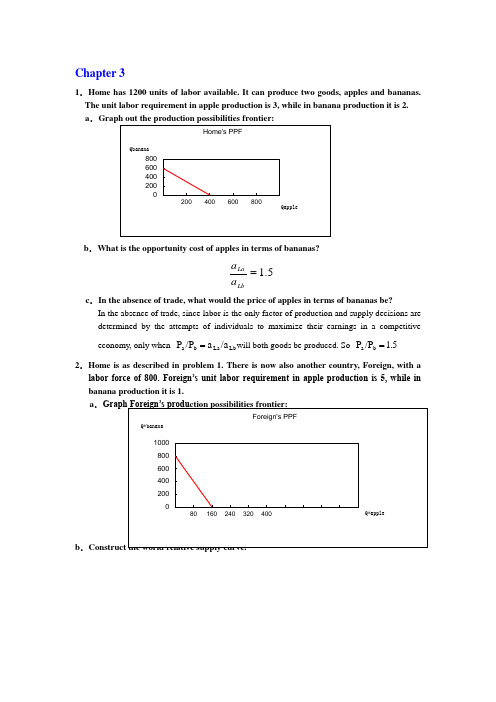
Chapter 31.Home has 1200 units of labor available. It can produce two goods, apples and bananas. The unit labor requirement in apple production is 3, while in banana production it is 2. a .b .What is the opportunity cost of apples in terms of bananas?5.1=LbLa a a c .In the absence of trade, what would the price of apples in terms of bananas be?In the absence of trade, since labor is the only factor of production and supply decisions aredetermined by the attempts of individuals to maximize their earnings in a competitive economy, only when Lb La b a /a a /P P =will both goods be produced. So 1.5 /P P b a =2.Home is as described in problem 1. There is now also another country, Foreign, with alabor force of 800. Foreign’s unit labor requirement in apple production is 5, while in banana production it is 1.a .b .3.Now suppose world relative demand takes the following form: Demand for apples/demand for bananas = price of bananas/price of apples.a .Graph the relative demand curve along with the relative supply curve:a b b a /P P /D D =∵When the market achieves its equilibrium, we have 1b a )(D D -**=++=ba b b a a P P Q Q Q Q ∴RD is a hyperbola xy 1=b .What is the equilibrium relative price of apples?The equilibrium relative price of apples is determined by the intersection of the RD and RScurves.RD: yx 1= RS: 5]5,5.1[5.1],5.0(5.0)5.0,0[=∈=⎪⎩⎪⎨⎧+∞∈=∈y y y x x x ∴25.0==y x∴2/=b P a P e ec .Describe the pattern of trade.∵b a b e a e b a P P P P P P ///>>**∴In this two-country world, Home will specialize in the apple production, export apples and import bananas. Foreign will specialize in the banana production, export bananas and import apples.d .Show that both Home and Foreign gain from trade.International trade allows Home and Foreign to consume anywhere within the coloredlines, which lie outside the countries’ production possibility frontiers. And the indirect method, specializing in producing only one production then trade with other country, is a more efficient method than direct production. In the absence of trade, Home could gain three bananas by foregoing two apples, and Foreign could gain by one foregoing five bananas. Trade allows each country to trade two bananas for one apple. Home could then gain four bananas by foregoing two apples while Foreign could gain one apple by foregoing only two bananas. So both Home and Foreign gain from trade.4.Suppose that instead of 1200 workers, Home had 2400. Find the equilibrium relative price. What can you say about the efficiency of world production and the division of the gains from trade between Home and Foreign in this case? RD: yx 1=RS: 5]5,5.1[5.1],1(1)1,0[=∈=⎪⎩⎪⎨⎧+∞∈=∈y y y x x x ∴5.132==y x∴5.1/=b P a P e eIn this case, Foreign will specialize in the banana production, export bananas and importapples. But Home will produce bananas and apples at the same time. And the opportunity cost of bananas in terms of apples for Home remains the same. So Home neither gains nor loses but Foreign gains from trade.5.Suppose that Home has 2400 workers, but they are only half as production in both industries as we have been assuming, Construct the world relative supply curve and determine the equilibrium relative price. How do the gains from trade compare with those in the case described in problem 4?In this case, the labor is doubled while the productivity of labor is halved, so the "effective labor "remains the same. So the answer is similar to that in 3. And both Home and Foreign can gain from trade. But Foreign gains lesser compare with that in the case4.6.”Korean workers earn only $2.50 an hour; if we allow Korea to export as much as it likes to the United State s, our workers will be forced down to the same level. You can’t import a $5 shirt without importing the $2.50 wage that goes with it.” Discuss.In fact, relative wage rate is determined by comparative productivity and the relative demand for goods. Kore a’s low wage reflects the fact that Korea is less productive than the United States in most industries. Actually, trade with a less productive, low wage country can raise the welfare and standard of living of countries with high productivity, such as United States. So this pauper labor argument is wrong.7.Japanese labor productivity is roughly the same as that of the United States in the manufacturing sector (higher in some industries, lower in others), while the United States, is still considerably more productive in the service sector. But most services are non-traded. Some analysts have argued that this poses a problem for the United States, because our comparative advantage lies in things we cannot sell on world markets. What is wrong with this argument?The competitive advantage of any industry depends on both the relative productivities of the industries and the relative wages across industries. So there are four aspects should be taken into account before we reach conclusion: both the industries and service sectors of Japan and U.S., not just the two service sectors. So this statement does not bade on the reasonable logic. 8.Anyone who has visited Japan knows it is an incredibly expensive place; although Japanese workers earn about the same as their U.S. counterparts, the purchasing power of their incomes is about one-third less. Extend your discussing from question 7 to explain this observation. (Hint: Think about wages and the implied prices of non-trade goods.) The relative higher purchasing power of U.S. is sustained and maintained by its considerably higher productivity in services. Because most of those services are non-traded, Japanese could not benefit from those lower service costs. And U.S. does not have to face a lower international price of services. So the purchasing power of Japanese is just one-third of their U.S. counterparts.9.How does the fact that many goods are non-traded affect the extent of possible gains from trade?Actually the gains from trade depended on the proportion of non-traded goods. The gains will increase as the proportion of non-traded goods decrease.10.We have focused on the case of trade involving only two countries. Suppose that there are many countries capable of producing two goods, and that each country has only one factor of production, labor. What could we say about the pattern of production and in this case? (Hint: Try constructing the world relative supply curve.)Any countries to the left of the intersection of the relative demand and relative supply curves export the good in which they have a comparative advantage relative to any country to the right of the intersection. If the intersection occurs in a horizontal portion then the country with that price ratio produces both goods.。
《国际经济学》课后习题参考答案
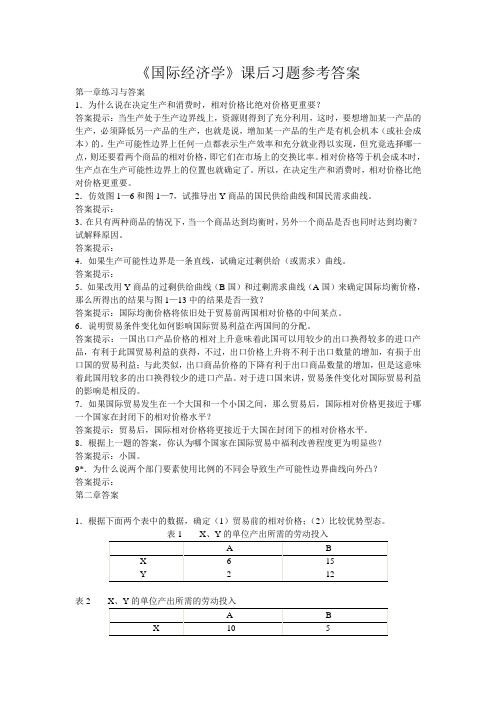
《国际经济学》课后习题参考答案第一章练习与答案1.为什么说在决定生产和消费时,相对价格比绝对价格更重要?答案提示:当生产处于生产边界线上,资源则得到了充分利用,这时,要想增加某一产品的生产,必须降低另一产品的生产,也就是说,增加某一产品的生产是有机会机本(或社会成本)的。
生产可能性边界上任何一点都表示生产效率和充分就业得以实现,但究竟选择哪一点,则还要看两个商品的相对价格,即它们在市场上的交换比率。
相对价格等于机会成本时,生产点在生产可能性边界上的位置也就确定了。
所以,在决定生产和消费时,相对价格比绝对价格更重要。
2.仿效图1—6和图1—7,试推导出Y商品的国民供给曲线和国民需求曲线。
答案提示:3.在只有两种商品的情况下,当一个商品达到均衡时,另外一个商品是否也同时达到均衡?试解释原因。
答案提示:4.如果生产可能性边界是一条直线,试确定过剩供给(或需求)曲线。
答案提示:5.如果改用Y商品的过剩供给曲线(B国)和过剩需求曲线(A国)来确定国际均衡价格,那么所得出的结果与图1—13中的结果是否一致?答案提示:国际均衡价格将依旧处于贸易前两国相对价格的中间某点。
6.说明贸易条件变化如何影响国际贸易利益在两国间的分配。
答案提示:一国出口产品价格的相对上升意味着此国可以用较少的出口换得较多的进口产品,有利于此国贸易利益的获得,不过,出口价格上升将不利于出口数量的增加,有损于出口国的贸易利益;与此类似,出口商品价格的下降有利于出口商品数量的增加,但是这意味着此国用较多的出口换得较少的进口产品。
对于进口国来讲,贸易条件变化对国际贸易利益的影响是相反的。
7.如果国际贸易发生在一个大国和一个小国之间,那么贸易后,国际相对价格更接近于哪一个国家在封闭下的相对价格水平?答案提示:贸易后,国际相对价格将更接近于大国在封闭下的相对价格水平。
8.根据上一题的答案,你认为哪个国家在国际贸易中福利改善程度更为明显些?答案提示:小国。
国际经济学第三章习题

《国际经济学》第三章习题(一)辨析题(判断正误,并说明原因)1、如果某一商品的价格上升将会导致该商品生产部门的劳动需求曲线向上移动。
2、短期内,如果劳动是可流动要素,那么某一商品上升会导致该部门资本-劳动比上升。
3、短期内,国际贸易一定会造成劳动力实际报酬的上升。
4、动态比较优势理论认为,一国出口模式将随产品生命周期的不同阶段和相对要素禀赋的变化而改变。
5、内部规模经济是指厂商的平均成本随着其自身规模的扩大而下降。
6、如果存在外部规模经济,即使不存在比较优势,也可以导致国际贸易的发生。
(二)问答题1、根据下面的两个表,试判断:(1)哪个国家是资本相对丰富的;(2)哪个国家是劳动相对丰富的;(3)如果X是资本密集型产品,Y是劳动密集型产品,那么两国的比较优势如何?表12、如何根据雷布津斯基定理,来解释要素禀赋不同的两个国家生产可能性边界之间的差别?3、假定在现有要素价格下,棉布生产中每用1英亩的土地就需要投入20小时的劳动,而在生产粮食时,每用1英亩的土地只需要投入5小时的劳动。
(1)假设该经济拥有的总资源量为:600小时的劳动和60英亩的土地。
请画图说明资源应如何分配。
(2)现在假设劳动供给首先上升到800小时,然后是1000小时,再然后是1200小时。
请用图展示出资源分配变化的轨迹。
(3)如果劳动供给继续增加将出现什么样的情形?4、如果一国的资本与劳动同时增加,那么在下列情况下,两种产品的生产以及该国的贸易条件如何变化?(1)资本、劳动同比例增加;(2)资本增加的比例大于劳动增加的比例;(3)资本增加的比例小于劳动增加的比例。
5、日本原本出口制造品,进口原材料如粮食、石油。
分析以下情况下日本贸易条件的变化:(1)中东战争使得石油供应紧缺(2)韩国扩展了汽车的生产能力,并在加拿大和美国进行销售(3)美国的工程师建立了核反应堆以代替石油燃料发电厂(4)俄罗斯农业歉收(5)日本降低牛肉和柑橘的进口关税6、在战后几十年间,日本、韩国等东亚的一些国家或地区的国际贸易商品结构发生了明显变化,主要出口产品由初级产品到劳动密集型产品,再到资本密集型产品。
国际经济学(克鲁格曼)课后习题答案1-8章
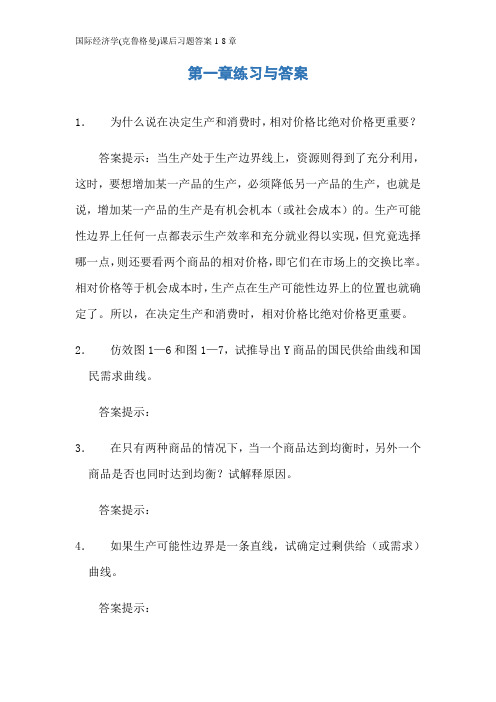
第一章练习与答案1.为什么说在决定生产和消费时,相对价格比绝对价格更重要?答案提示:当生产处于生产边界线上,资源则得到了充分利用,这时,要想增加某一产品的生产,必须降低另一产品的生产,也就是说,增加某一产品的生产是有机会机本(或社会成本)的。
生产可能性边界上任何一点都表示生产效率和充分就业得以实现,但究竟选择哪一点,则还要看两个商品的相对价格,即它们在市场上的交换比率。
相对价格等于机会成本时,生产点在生产可能性边界上的位置也就确定了。
所以,在决定生产和消费时,相对价格比绝对价格更重要。
2.仿效图1—6和图1—7,试推导出Y商品的国民供给曲线和国民需求曲线。
答案提示:3.在只有两种商品的情况下,当一个商品达到均衡时,另外一个商品是否也同时达到均衡?试解释原因。
答案提示:4.如果生产可能性边界是一条直线,试确定过剩供给(或需求)曲线。
答案提示:5.如果改用Y商品的过剩供给曲线(B国)和过剩需求曲线(A 国)来确定国际均衡价格,那么所得出的结果与图1—13中的结果是否一致?答案提示:国际均衡价格将依旧处于贸易前两国相对价格的中间某点。
6.说明贸易条件变化如何影响国际贸易利益在两国间的分配。
答案提示:一国出口产品价格的相对上升意味着此国可以用较少的出口换得较多的进口产品,有利于此国贸易利益的获得,不过,出口价格上升将不利于出口数量的增加,有损于出口国的贸易利益;与此类似,出口商品价格的下降有利于出口商品数量的增加,但是这意味着此国用较多的出口换得较少的进口产品。
对于进口国来讲,贸易条件变化对国际贸易利益的影响是相反的。
7.如果国际贸易发生在一个大国和一个小国之间,那么贸易后,国际相对价格更接近于哪一个国家在封闭下的相对价格水平?答案提示:贸易后,国际相对价格将更接近于大国在封闭下的相对价格水平。
8.根据上一题的答案,你认为哪个国家在国际贸易中福利改善程度更为明显些?答案提示:小国。
9*.为什么说两个部门要素使用比例的不同会导致生产可能性边界曲线向外凸?答案提示:第二章答案1.根据下面两个表中的数据,确定(1)贸易前的相对价格;(2)比较优势型态。
克鲁格曼《国际经济学》中文版·第九版课后习题答案

克鲁格曼《国际经济学》中文版·第九版课后习题答案克鲁格曼《国际经济学》中文版·第九版课后习题答案第一章练习与答案1.为什么说在决定生产和消费时,相对价格比绝对价格更重要?答案提示:当生产处于生产边界线上,资源则得到了充分利用,这时,要想增加某一产品的生产,必须降低另一产品的生产,也就是说,增加某一产品的生产是有机会机本(或社会成本)的。
生产可能性边界上任何一点都表示生产效率和充分就业得以实现,但究竟选择哪一点,则还要看两个商品的相对价格,即它们在市场上的交换比率。
相对价格等于机会成本时,生产点在生产可能性边界上的位置也就确定了。
所以,在决定生产和消费时,相对价格比绝对价格更重要。
2.仿效图1—6和图1—7,试推导出Y商品的国民供给曲线和国民需求曲线。
答案提示:3.在只有两种商品的情况下,当一个商品达到均衡时,另外一个商品是否也同时达到均衡?试解释原因。
答案提示:4.如果生产可能性边界是一条直线,试确定过剩供给(或需求)曲线。
答案提示:5.如果改用Y商品的过剩供给曲线(B国)和过剩需求曲线(A 国)来确定国际均衡价格,那么所得出的结果与图1—13中的结果是否一致?答案提示:国际均衡价格将依旧处于贸易前两国相对价格的中间某点。
6.说明贸易条件变化如何影响国际贸易利益在两国间的分配。
答案提示:一国出口产品价格的相对上升意味着此国可以用较少的出口换得较多的进口产品,有利于此国贸易利益的获得,不过,出口价格上升将不利于出口数量的增加,有损于出口国的贸易利益;与此类似,出口商品价格的下降有利于出口商品数量的增加,但是这意味着此国用较多的出口换得较少的进口产品。
对于进口国来讲,贸易条件变化对国际贸易利益的影响是相反的。
7.如果国际贸易发生在一个大国和一个小国之间,那么贸易后,国际相对价格更接近于哪一个国家在封闭下的相对价格水平?答案提示:贸易后,国际相对价格将更接近于大国在封闭下的相对价格水平。
国际经济学理论与政策第三章答案

♦ The opportunity cost of producing roses is the amount of computers not produced.
3-8
2
Comparative Advantage and Opportunity Cost (cont.)
• The US has a lower opportunity cost in producing computers.
♦ Ecuador can produce 30,000 computers, compared to 10 million roses that it could otherwise produce.
Copyright © 2006 Pearson Addison-Wesley. All rights reserved.
3-3
Introduction (cont.)
• The Ricardian model (chapter 3) says differences in productivity of labor between countries cause productive differences, leading to gains from trade.
♦ The US can produce 10 million roses, compared to 100,000 computers that it could otherwise produce.
Copyright © 2006 Pearson Addison-Wesley. All rights reserved.
20秋《国际经济学》作业3【北语答案53315】

3.跨国公司是指在两个或两个以上国家的实体所组成的公营、私营或混合所有制形式的企业。 A.正确 B.错误
4.在外汇市场上,如果投机者预测日元将会贬值,美元将会升值,即进行卖出美元买入日元的即期 外汇交易。 A.正确 B.错误
5.跨国公司内部的贸易只要跨越国界,都应作为国际贸易记入相关国家的国际收支账上。 A.正确 B.错误
3.下述哪一种属于国际收支的事后项目 )。 A.进出口 B.利息收支 C.直接投资 D.特别提款权变动
4.不完全竞争企业以低于国内市场的价格向国外销售商品的行为称为()。 A.贸易 B.垄断 C.倾销 D.反倾销
5.国际收支调节的吸收分析方法的提出者是()。 A.凯恩斯 B.马歇尔 C.亚历山大 D.罗宾逊
B.资本项目 C.官方结算项目 D.错误与遗漏项目
9.开放经济条件下的均衡意味着()。 A.国际收支与商品市场同时均衡 B.国际收支与货币市场同时均衡 C.商品市场和货币市场同时均衡 D.国际收支、商品市场与货币市场的同时均衡
10.外汇管制针对的活动不包括()。 A.外汇收付 B.外汇买卖 C.外汇借贷 D.外汇转移
20秋《国际经济学》作业3 红字部分为答案!
单选题 1.一国经济的对外均衡,就是实现()。 A.物价稳定 B.国际收支平衡 C.经济稳定增长 D.充分就业
2.下列哪种理论适用于解释发生在发达国家之间的产业内贸易即制造业内部的一种水平式贸易。() A.规模经济理论 B.要素禀赋理论 C.重叠需求理论 D.产品生命周期理论
4.国际收支的各种差额中,基本差额包括 )。 A.商品贸易收支 B.服务贸易收支 C.官方结算收支 D.长期资本项目收支
5.下列属于国际间接投资的类型的是()。 A.国际贷款 B.国际证券投资 C.创办新企业 D.控股权投资
萨尔瓦多国际经济学第三章课后练习题答案

1.在一个坐标系内,画一条凹向原点的生产可能性曲线:(1)从生产可能性曲线的中点开始用箭头表示该国在生产更多X(横轴表示的商品)和更多Y时所发生的机会成本递增情况。
(2)当生产更多的X时,生产可能性曲线的斜率如何变化?生产更多的Y呢?这种变化反映了什么?答:(1)图1 生产可能性曲线(3)如上图所示,当生产更多的X时,生产可能性曲线的斜率变大;当生产更多的Y时,生产可能性曲线的斜率变大。
原因是当该国生产更多的X或Y时,机会成本会变大。
2.在另一个坐标系内,画三条社会无差异曲线,并令最高的两条相交:(1) 社会无差异曲线为什么向下倾斜,或者说斜率为负?(2)曲线的斜率代表什么?为什么每条无差异曲线在较低点斜率较小?(3)考虑相交的两条无差异曲线,是在交点右边的还是在交点左边的曲线表示的满足程度较高?为什么和无差异曲线的定义不一致?你可以得出什么结论?答:图2 社会无差异曲线(1)社会无差异曲线之所以会向下倾斜是因为为了维持社会福利水平不变,随着X商品消费的增加必须减少Y的消费。
(2)曲线的斜率代表一国在保持处在同一条无差异曲线的前提下,多消费一单位x而必须少消费Y的数量。
一国消费X越多,则其消费Y越少。
对该国来说,一单位Y的效用会逐渐增大。
因此,该国每多消费一单位X,只会放弃越来越少的Y商品。
所以,无差异曲线在较低点斜率较小。
(3)无差异曲线的定义表明每条无差异曲线意味着一个给定的满足程度,无差异曲线互不相交。
无差异曲线II显示了比交点右边更高的满足程度,无差异曲线II显示了比交点左边更高的满足程度。
因此,这个图是不合理。
3.在一个坐标系内,画一条生产可能性曲线,再画一条无差异曲线切于生产可能性曲线较平坦的地方,在另一个坐标系内,面另一条生产可能性曲线,再画另一条无差异曲线切于生产可能性曲线较陡直的地方。
(1)画一条表示各国孤立均衡相对价格的直线。
(2)各国具有比较优势的商品分别是什么?(3)在什么(极端)情况下,两国之间不存在比较优势或比较劣势?答:国家1 国家2图3 孤立均衡(1)如图3所示,P A和P A’是两国在孤立均衡情况下的价格。
国际经济学第三章课后习题答案

2.本国共有1200单位的劳动,能生产两种产品:苹果和香蕉。
苹果的单位产品劳动投入是3,香蕉的单位产品劳动投入是 2.a。
画出本国的生产可能性边界。
b.用香蕉衡量的苹果的机会成本是多少?c.贸易前,苹果对香蕉的相对价格是多少?为什么?a.b.c.在贸易前,当劳动是生产的唯一要素,且在竞争日益激烈的经济环境中,供给决策是由个人获得的最大收益决定时,只有当时,这两种货物才能被生产。
所以,教科书问题的答案1. a。
生产可能性曲线是一条直线,截获苹果轴在400(1200/3)和香蕉轴上600(1200/2)。
b。
机会成本的苹果,香蕉是3/2而言。
它需要3个单位的劳动收获一个苹果,但是只有两个单位的劳动收获一根香蕉。
如果一个人foregoes收获一个苹果,这释放3个单位的劳动。
这3个单位的劳动就能够被用来收获1.5香蕉。
c。
劳动力流动,保证了每一个环节上常见的工资和竞争保证了货物的价格等于他们的生产成本。
因此,相对价格的相对成本相等时,它等于倍的工资单位劳动条件为苹果的工资倍除以单位劳动要求香蕉。
由于工资是平等的交叉,价格比率之比相等单位劳动要求,为苹果每2是3个香蕉。
2,3,6,7,11,14]。
生产可能性曲线是线性的,在苹果和拦截800/5相当于160(轴)和拦截踩在香蕉轴等于800(800/1)。
b。
世界相对供给曲线,建立确定供应苹果相对于供应的香蕉在每个相对价格。
最低的相对价格,比如苹果是收获3苹果每2个香蕉。
供给曲线是平的相对这个价钱。
苹果的最大数量的价格提供3/2在家里是400所提供的同时,以这样的价格,外国的丰收,800香蕉和没有苹果给最大相对供应以这个价格的1 / 2。
这种相对供应价格之间3/2适用任何和五日。
的价格是5,两国将在收成苹果。
供给曲线是又相对平坦的5。
因此,相关的供给曲线是一步成型,公寓,租金价格相对而言3/2供应为0到1 / 2,垂直的,从3/2数量相对半上升到5元,然后再从半无限地来讲一个。
奥鹏《国际经济学》在线作业三答案

奥鹏《国际经济学》在线作业三答案一、单选题(共 15 道试题,共 60 分。
)V1. 根据政策配合说,被分派去管理外部均衡的是( B )A. 汇率政策B. 货币政策C. 外汇政策D. 财政政策满分:4 分2. 古典利率平价理论的提出者是经济学家( B )A. 卡塞尔B. 凯恩斯C. 艾因齐格D. 弗里得曼满分:4 分3. 大国实施出口补贴之所以受损失更大,是因为( D )A. 大国的实力不强B. 大国的财政补贴太多C. 大国的进口量太大D. 大国会影响国际市场价格满分:4 分4. 根据孟代尔-弗莱明模型,在浮动汇率制下,财政政策(A )A. 完全失效B. 完全有效C. 同货币政策作用一致D. 无法判断满分:4 分5. 对于小国征收关税,下列说法正确的是( D )A. 消费者可能从中获益B. 生产者会有净损失C. 政府会损失关税收入D. 国家的净福利不可能为正满分:4 分6. 根据相互需求原理,决定两国产品交换实际比例的关键因素是( C )A. 两国的要素禀赋B. 两国的比较优势C. 两国的相对需求强度D. 两国的技术水平满分:4 分7. 赫-俄模型研究的是( C )A. 贸易的作用B. 贸易的利益分配C. 贸易的模式D. 贸易对收入的影响满分:4 分8. 购买力平价理论的基础是( C )A. 利率平价成立B. 铸币平价成立C. 一价定律成立D. 汇兑心理说满分:4 分9. 根据对外贸易乘数理论,在其他条件不变的条件下,边际进口倾向同对外贸易乘数值呈( A )A. 反向关系B. 无关联C. 正向关系D. 无法判断满分:4 分10. 对小国而言,最优关税( B )A. 是最高关税B. 是零关税C. 是禁止性关税D. 介于零关税和禁止性关税之间满分:4 分11. 根据货币主义汇率理论,在其他条件不变的情况下,一国的国民收入增长快于其他国家会导致该国货币汇率( A )A. 上升B. 下跌C. 不变D. 难以判断满分:4 分12. 根据货币主义汇率理论,在其他条件不变的情况下,一国的货币供应量相对于其他国家增加会导致该国货币汇率( B )A. 上升B. 下跌C. 不变D. 难以判断满分:4 分13. 根据IMF对国际收支的定义,"经济体"的含义比国家要( A )A. 广B. 窄C. 二者相同A.B.C.D.E.A.B.C.D. 价格效应E. 贸易条件效应满分:4 分3. 根据H-O-S定理,国际贸易将会(AB )A. 提高劳动力丰裕国家的劳动力价格B. 降低资本丰裕国的劳动力价格C. 提高劳动力丰裕国家的资本价格D. 降低资本丰裕国的资本价格E. 以上说法都对满分:4 分4. 根据吸收分析理论,纠正贸易逆差的政策有(DE)A. 贬值B. 增加货币发行量C. 提高利率D. 增加产量E. 减少支出满分:4 分5. 比较优势理论的贡献在于(AB)A. 打破了绝对优势理论的严格假设B. 肯定了国际贸易同国内贸易的不同特征C. 对国际贸易进行了动态分析D. 探讨了贸易的利益分配问题E. 分析了两国之间的交换比价满分:4 分6. 关境是海关管辖的势力范围,同国境相比,二者(ABC)A. 很可能一致B. 关境有可能大于国境C. 关境有可能小于国境D. 二者无法比较E. 上述说法都不正确满分:4 分7. 按照政府是否干预,浮动汇率制可以分为(BC)A. 单独浮动B. 清洁浮动C. 管理浮动D. 钉住浮动E. 联合浮动满分:4 分8. 浮动汇率制按其浮动方式,可以分为(ADE)A. 单独浮动B. 清洁浮动C. 管理浮动D. 钉住浮动E. 联合浮动满分:4 分9. 赫-俄模型假定(ABCDE)A. 两国的技术水平相同B. 要素在两国间完全不能流动C. 两种产品的生产都具有规模报酬不变的特点D. 没有运输成本E. 两国的资源都得到了充分利用A.B.C.D.E.放心做题好了,只要学科对了,学校对了,肯定100分。
国际经济学课后答案(word版)

第三章复习题(1),本国共有1200单位的劳动,能生产两种产品:苹果和香蕉。
苹果的单位产品劳动投入是3,香蕉的单位劳动产品投入时2。
a.画出本国的生产可能性边界。
b.用香蕉衡量的苹果的机会成本是多少?c.贸易前,苹果对香蕉的相对价格是多少?为什么?答:a.本国的生产可能性边界曲线是一条直线,在400(1200/3)处与苹果轴相截,在600(1200/2)处与香蕉轴相截,如图2-7所示。
b.用香蕉衡量苹果的机会成本是3/2。
生产1单位苹果需要3单位的劳动,生产1单位香蕉需要2单位的劳动。
如果放弃1单位苹果的生产,这将释放出3单位的劳动。
这2单位的劳动可以被用来生产3/2单位的香蕉。
c.劳动的流动性可以使得各个部门的工资趋同,竞争可以使得商图2-7 本国生产可能性曲品的价格等于它们的生产成本。
这样,相对价格等于相对成本,而相对成本等于工资乘以苹果的单位劳动产品投入。
因为各个部门工资相等,所以价格比率等于单位产品劳动投入的比率,即生产苹果所需的3单位劳动与生产香蕉所需的2单位劳动比率。
(2)假设本国的情况和习题1相同。
外国拥有800单位的劳动,外国苹果的单位劳动投入是5,香蕉的单位产品劳动投入是1。
a.画出外国的生产可能性边界。
b.画出世界相对供给曲线。
答:a.外国的生产可能性边界曲线是一条直线,在160(800/5)处与苹果轴相截,在800(800/1)处与香蕉轴相截。
如图2-8所示。
b.世界相对供给曲线可以由苹果和香蕉的相对价格和相对供给量绘出。
如图2-9。
从图2-9可以看出,苹果对香蕉的最低相对价格是3/2,在这个价格上,苹果的世界相对供给曲线是水平的。
在3/2的相对价格上,本国对苹果的最大供给量是400,外国对香蕉的供给量是800,这时,相对供给量为1/2。
只要相对价格保持在3/2和5之间,相对供给量就不变。
如果相对价格成为5,两个国家都会生产苹果,香蕉的产量为零。
这时,相对供给曲线是水平的。
克鲁格曼《国际经济学》中文版·第九版 课后习题答案
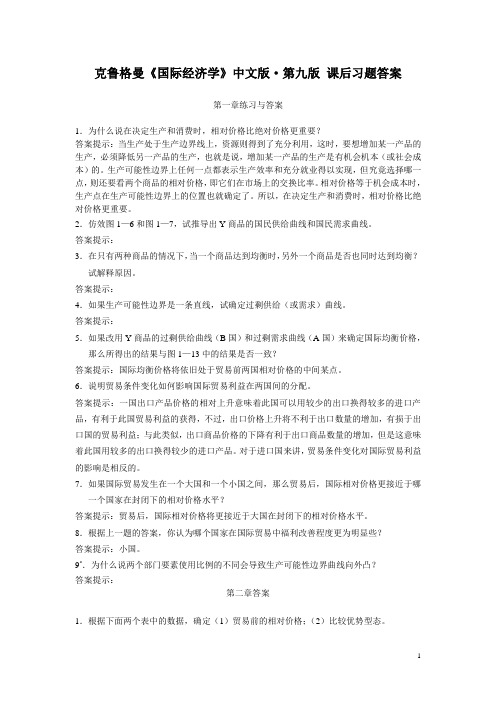
克鲁格曼《国际经济学》中文版·第九版课后习题答案第一章练习与答案1.为什么说在决定生产和消费时,相对价格比绝对价格更重要?答案提示:当生产处于生产边界线上,资源则得到了充分利用,这时,要想增加某一产品的生产,必须降低另一产品的生产,也就是说,增加某一产品的生产是有机会机本(或社会成本)的。
生产可能性边界上任何一点都表示生产效率和充分就业得以实现,但究竟选择哪一点,则还要看两个商品的相对价格,即它们在市场上的交换比率。
相对价格等于机会成本时,生产点在生产可能性边界上的位置也就确定了。
所以,在决定生产和消费时,相对价格比绝对价格更重要。
2.仿效图1—6和图1—7,试推导出Y商品的国民供给曲线和国民需求曲线。
答案提示:3.在只有两种商品的情况下,当一个商品达到均衡时,另外一个商品是否也同时达到均衡?试解释原因。
答案提示:4.如果生产可能性边界是一条直线,试确定过剩供给(或需求)曲线。
答案提示:5.如果改用Y商品的过剩供给曲线(B国)和过剩需求曲线(A国)来确定国际均衡价格,那么所得出的结果与图1—13中的结果是否一致?答案提示:国际均衡价格将依旧处于贸易前两国相对价格的中间某点。
6.说明贸易条件变化如何影响国际贸易利益在两国间的分配。
答案提示:一国出口产品价格的相对上升意味着此国可以用较少的出口换得较多的进口产品,有利于此国贸易利益的获得,不过,出口价格上升将不利于出口数量的增加,有损于出口国的贸易利益;与此类似,出口商品价格的下降有利于出口商品数量的增加,但是这意味着此国用较多的出口换得较少的进口产品。
对于进口国来讲,贸易条件变化对国际贸易利益的影响是相反的。
7.如果国际贸易发生在一个大国和一个小国之间,那么贸易后,国际相对价格更接近于哪一个国家在封闭下的相对价格水平?答案提示:贸易后,国际相对价格将更接近于大国在封闭下的相对价格水平。
8.根据上一题的答案,你认为哪个国家在国际贸易中福利改善程度更为明显些?答案提示:小国。
- 1、下载文档前请自行甄别文档内容的完整性,平台不提供额外的编辑、内容补充、找答案等附加服务。
- 2、"仅部分预览"的文档,不可在线预览部分如存在完整性等问题,可反馈申请退款(可完整预览的文档不适用该条件!)。
- 3、如文档侵犯您的权益,请联系客服反馈,我们会尽快为您处理(人工客服工作时间:9:00-18:30)。
Home has a comparative advantage in both products.
The opportunity cost of cloth in terms of widgets in Foreign is if it is ascertained that Foreign uses
neither country will want to export the good in which it enjoys comparative advantage.
both countries will want to specialize in cloth.
Given the following information:
both countries could benefit from trade with each other.
neither country could benefit from trade with each other.
each country will want to export the good in which it enjoys comparative advantage.
each country enjoys superior terms of trade.
each country has a more elastic demand for the imported goods.
each country has a more elastic supply for the supplied goods.
—The Ricardian Model
Multiple Choice Questions
Countries trade with each other because they are _______ and because of ______.
different, costs
similar, scale economies
export cloth.
export widgets.
export both and import nothing.
export and import nothing.
All of the above.
If the world equilibrium price of widgets were 4 Cloths, then
that country’s exchange rate is low.
wage rates in that country are high.
the output per worker of widgets as compared to the output of some other product is higher in
both countries could benefit from trade with each other.
neither country could benefit from trade with each other.
(c) each country will want to export the good in which it enjoys comparative advantage. (d) neither country will want to export the good in which it enjoys comparative advantage. (e) both countries will want to specialize in cloth. Answer: A 16. In a two product two country world, international trade can lead to increases in (a) consumer welfare only if output of both products is increased. (b) output of both products and consumer welfare in both countries. (c) total production of both products but not consumer welfare in both countries. (d) consumer welfare in both countries but not total production of both products. (e) None of the above Answer: B 17. As a result of trade, specialization in the Ricardian model tends to be (a) complete with constant costs and with increasing costs. (b) complete with constant costs and incomplete with increasing costs. (c) incomplete with constant costs and complete with increasing costs. (d) incomplete with constant costs and incomplete with increasing costs. (e) None of the above. Answer: B 18. As a result of trade between two countries which are of completely different economic sizes, specialization in the Ricardian 2X2 model tends to be (a) incomplete in both countries (b) complete in both countries (c) complete in the small country but incomplete in the large country (d) complete in the large country but incomplete in the small country (e) None of the above Answer: C 19. A nation engaging in trade according to the Ricardian model will find its consumption bundle (a) inside its production possibilities frontier. (b) on its production possibilities frontier. (c) outside its production possibilities frontier. (d) inside its trade-partner’s production possibilities frontier. (e) on its trade-partner’s production possibilities frontier. Answer: C
Both (c) and (d).
The Ricardian theory of comparative advantage states that a country has a comparative advantage
output per worker of widgets is higher in that country.
Both (b) and (c).
In order to know whether a country has a comparative advantage in the production of one particular
one
two
three
four
five
5. A country engaging in trade according to the principles of comparative advantage gains from trade because it (a) is producing exports indirectly more efficiently than it could alternatively. (b) is producing imports indirectly more efficiently than it could domestically. (c) is producing exports using fewer labor units. (d) is producing imports indirectly using fewer labor units. (e) None of the above. Answer: B 6. Given the following information: Unit Labor Requirements Cloth Widgets Home 10 20 Foreign 60 30 (a) Neither country has a comparative advantage. (b) Home has a comparative advantage in cloth. (c) Foreign has a comparative advantage in cloth. (d) Home has a comparative advantage in widgets. (e) Home has a comparative advantage in both products. Answer: B 7. If it is ascertained that Foreign uses prison-slave labor to produce its exports, then home should (a) export cloth. (b) export widgets. (c) export both and import nothing. (d) export and import nothing. (e) All of the above. Answer: A 8. If the Home economy suffered a meltdown, and the Unit Labor Requirements in each of the products quadrupled (that is, doubled to 30 for cloth and 60 for widgets) then home should (a) export cloth. (b) export widgets. (c) export both and import nothing. (d) export and import nothing. (e) All of the above. Answer: A 9. If wages were to double in Home, then Home should: (a) export cloth. (b) export widgets. (c) export both and import nothing. (d) export and import nothing. (e) All of the above. Answer: A 10. If the world equilibrium price of widgets were 4 Cloths, then
